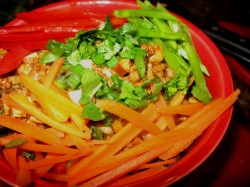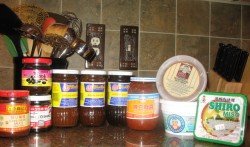Soybean Pastes: A Primer
Since I wrote the primer on soy sauces, I thought I should probably talk a little about the different kinds of fermented soybean pastes there are in Asian cookery, too. They are nearly as important as flavor enhancers as soy sauce, and the variation in flavor, color and texture in these sauces and pastes is amazing.
And, as I have come to learn, you cannot really substitute different kinds of soybean paste in recipes.
Once again, my bias is toward Chinese cookery, though I also have some knowledge of the giant of the Japanese kitchen: miso. I know that there are many more different varieties of soybean pastes in Asia than the ones I am listing here, but this is just a quick and dirty guide meant to get readers started on knowing the difference between the varieties, what they are used for and how to use them.
As with soy sauces, if you are doing primarily Chinese cooking, buy Chinese fermented soybean pastes; do not try to substitute miso. Miso has a completely different flavor and character, probably owing to the fact that rice or barley are also ingredients of miso. Wheat is most often an ingredient in Chinese soy pastes, and this, I think makes a great difference, though it will also mean that people with gluten sensitivities will have to either avoid the ingredient entirely or go against my general dictum and use miso. My feeling on that issue is simple: you have to do what you have to do for your health. Use the miso and tamari and don’t worry about it.
But for everyone else, please, don’t use miso in place of Chinese soybean sauces and pastes. I have been there, done that, and brought back t-shirts for everyone; it just won’t taste right. Not only are the grains used in them different, my suspicion is that the organisms that are used to ferment the bean and grain mixture are totally different. As any homebrewer or sourdough baker will know, this will make a large difference in overall flavor.
Now that we have that dictum out of the way, let’s talk about the different varieties of fermented soybean pastes in the Asian market.
Let’s start with miso. Made of soybeans, rice and/or barley, and salt that has been inoculated with Aspergillus oryzae, a mold, miso becomes a protein-rich paste that varies widely in color and flavor depending upon the ingredients used, the length of fermentation, how finely the ingredients are ground before fermentation, and how the paste is treated after fermentation. The most commonly found miso pastes in the United States are the pale, mild and slightly sweet shiro miso (shiro means “white”), and the darker, saltier, more robust aka miso. (Aka means “red”.) Hatcho miso, which originated in the town of Hatcho, is also becoming more common in the United States–it is aged for three years and has a very complex, smoky flavor. There are even lower-sodium versions of miso now available; Miso Master, a company in California that makes organic, hand-made misos, has a very delicious lower sodium shiro miso that I like a great deal.
Miso is most often encountered by Americans in miso soup at sushi bars, and, in truth, much of it is consumed that way in Japan as well. However, it is also used as an ingredient in pickle-making, in marinades for grilled and broiled fish, meats and vegetables, and in stews. It is a very versatile condiment, and is highly nutritious, being filled with protein and B vitamins.
Miso-making, however, did not originate in Japan. Historians believe that the method of making fermented soybean paste came from China in the seventh century. In China, fermented soybean paste, called chiang, had been made for thousands of years. Once chiang came to Japan, however, the methods and materials for producing it diverged and miso developed into a distinct, differently-flavored condiment.
The Chinese are said to have learned how to make chiang from the Koreans who called it “jang.” I know very little about Korean foods, however (it is one of my next realms of study), so I will move on to the various different types of fermented soybean pastes used in the Chinese kitchen.
Hoisin sauce, sometimes also called “sweet bean paste,” is probably the most familiar variety of fermented soybean paste to Americans. Heavily sweetened with sugar and seasoned with vinegar and garlic, hoisin sauce is a thick, nearly black paste that is sweet, tangy and savory all at once. It is used both as an ingredient, and as a table condiment; it is used to moisten and sweeten the pancakes served with Peking Duck and mu shu. It is featured in many familiar dishes, including some versions of Kung Pao, and the marinade for char sui. The brand I have used for years is Koon Chun from Taiwan, which comes in a shapely jar with a yellow, blue, white and red label that is printed in Chinese on one side, and English on the other.
Bean sauce or ground bean sauce are my favorite of the Chinese fermented soybean pastes, and I think they are the most versatile. A medium brown in color, the only difference is that the ground bean sauce is pureed into a thick, smooth paste, while the plain bean sauce is chunkier; they both contain the same ingredients: soy beans, salt, wheat, sugar, sesame oil and unidentified spices. Salty and robust, these sauces are similar in flavor to aka miso, but are not as sharp or as obviously saline in nature. They are used as the main flavoring ingredient in many dishes, including ja ziang mein and bean sauce chicken. Just a teaspoon or so added to a marinade or a sauce adds a great boost in flavor that is delicious, yet mysterious, particularly if you are unfamiliar with it as an ingredient. Once again, I prefer the Koon Chun brand.
Broad bean paste with chile is a Sichuanese ingredient that is a necessity in my kitchen. It is what gives Sichuan Red Cooked Beef with Turnips and Ma Po Tofu their distinctive brick red color, strong tangy flavor and chile heat. Made from a mixture of fermented soybeans, broad beans and wheat, then seasoned with salt, sesame oil and chiles, the scent and flavor of this paste is very unique. It has a pleasant alcoholic mustiness that is difficult to decribe otherwise. But it is what gives many Sichuanese dishes their very strong flavor, and using chile garlic paste as a substitute does not work. The brand that I favor comes from Taiwan and is made by the Ming Teh Food Industry Company. It has a yellow, red and blue label with a globe on it and very little English lettering. It is often hard to find, so I can also recommend the more readily available Lee Kum Kee brand.
There are many other brands and types of Chinese fermented soy bean pastes out there. I just highlighted the three most useful and versatile of them, which are nearly always present in my kitchen, along with some recipes where they are necessary to create a distinctive flavor.
And now, I will give you a recipe that uses all three Chinese fermented soybean pastes in one dish; it is a variation on Ja Jiang Mein, but is sweeter, and utilizes more vegetables and tofu than the original recipe did. I also spiced it up considerably by adding five Thai bird chiles to the ginger, garlic and onions that traditionally flavor the noodles of Beijing.
I call the dish, “King Du Noodles,” after a similar dish made at the Hometown Deli and Carryout restaurant in Columbus, Ohio, which is one of the two places we always stop for Chinese food when we visit.

King Du Noodles
Ingredients:
2 tablespoons peanut oil
1 medium onion, diced finely
2″ cube fresh ginger, minced
5 garlic cloves, minced
3-6 Thai bird chiles sliced thinly
2 fresh or dried rehydrated shiitake mushrooms, diced
8 ounces pressed spiced tofu, diced finely
3/4 pound ground or minced pork
1 tablespoon hoisin sauce
1 tablespoon Sichuan hot bean sauce (broad bean paste with chiles)
1 tablespoon soy bean sauce
1 teaspoon sugar
1 teaspoon freshly ground Sichuan peppercorns
1 teaspoon freshly ground pepper
3 tablespoons Shao Hsing wine
1/2 cup chicken broth
1 1/2 tablespoons cornstarch dissolved in 1 tablespoon chicken broth
1/2 cup sliced scallion tops
1 cup loosely packed cilantro leaves, roughly chopped
1 teaspoon sesame oil
1 cup shredded carrot
1 cup shredded snow peas
1 red sweet bell pepper, shredded
1 pound fresh egg noodles, cooked al dente and drained
Method:
Heat wok until a thin wisp of white smoke coils up from it. Add oil and heat until it shimmers. When it is ready, add onions and cook and stir until they are just beginning to take on color. Add ginger, garlic, chiles, and mushrooms and stir fry until fragrant–about forty-five seconds or so. Add pressed tofu and continue stir frying another minute.
Add pork, soy bean pastes/sauces, Sichuan pepper, pepper and sugar, and stir fry, chopping at the meat to separate it with your wok shovel. Cook until most of the pink is gone from the meat.
Add wine, cook off alcohol. Add chicken broth and cornstarch mixture, cook, stirring, until thickened. Add sliced scallion tops and cilantro, stir to combine.
Remove from heat, drizzle with sesame oil.
Divide noodles into bowls, and top with meat sauce and vegetable shreds.
6 Comments
RSS feed for comments on this post.
Sorry, the comment form is closed at this time.
Powered by WordPress. Graphics by Zak Kramer.
Design update by Daniel Trout.
Entries and comments feeds.




Congratulations Barbara ! For winning the Best Post award.
Comment by Sonali — March 7, 2006 #
Thank you, Sonali!
Comment by Barbara — March 7, 2006 #
Thank you for a nice view of the soybean pastes. I never quite realized the differences.
Regarding Korean food, two words define much of the cuisine to me: gochujang and kimchi. (I was married to a Korean for most of a decade. I acquired a love of Korean food that survived the marriage and has not lessened in the subsequent years.)
Both gochujang and kimchi come in so many variants, and are so essential to the cuisine and even the culture, exploring just those two elements would illuminate much of the entire cuisine.
Enjoy your exploration of Korean cooking, Barbara. 🙂
Comment by Dan Jenkins — March 12, 2006 #
Dan, I love kimchee. Absolutely adore it. It is one of the few things about Korean food I know–I have actually made it in culinary school, and eaten tons of it. My Korean friend, Chris, at Johnson & Wales got me addicted to it.
A couple of years ago, I was pregnant for a short while before a miscarriage ended the pregnancy. While I was pregnant and nauseous beyond belief, one thing over all did I crave–kimchee. When we visited Maryland to sign some legal documents and visit friends in the Balto-Washington area, I went shopping at my favorite Asian market, the superstore-sized Lotte, and bought a gallon-sized jar of kimchee and it drove carefully back with us to Ohio.
I still love the stuff, but I have not convinced either Zak or Morganna to try it. The ferocious smell frightens them away.
More for me, I say.
Comment by Barbara — March 12, 2006 #
Very useful info. Thanks. Do you have a recipe for making one’s own Chile Bead Paste or Doubanjiang ie fermented broad beans etc? I intend to try, but would prefer some guidelines to avoid potential disaster!
JontyB
Comment by jonty boyce — August 6, 2007 #
Love the information. thanks. I look forward to trying some of the other recipes. right now I use it with green beans stir fry. Have you guys tried Lan Chi Broad Bean sauce? It’s harder to find but I like it far superior than the other brands out there. It’s worth the effort. I actually found it on amazon.
Comment by Stephanie — December 15, 2007 #